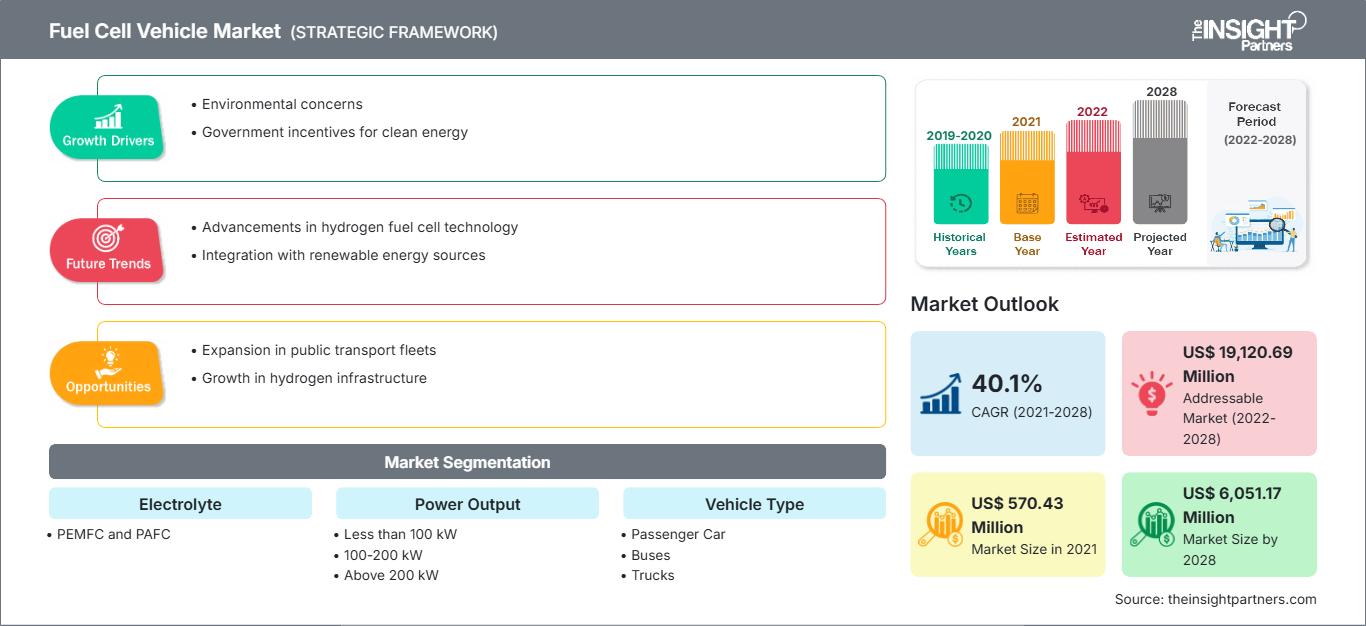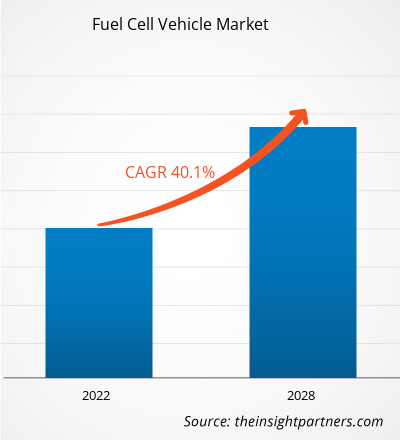[研究报告] 燃料电池汽车市场规模预计将从 2021 年的 5.7043 亿美元增至 2028 年的 60.5117 亿美元;预计 2021 年至 2028 年的复合年增长率为 40.1%。
分析师观点:
近年来,燃料电池汽车市场作为传统汽油动力汽车的有前途的替代品,获得了广泛的关注和发展。燃料电池汽车 (FCV) 由氢燃料电池提供动力,燃料电池通过氢和氧之间的化学反应产生电能,产生的排放物只有水蒸气。FCV 的主要优势之一是其环保性。由于它们只排放水蒸气,因此有助于减少温室气体排放和空气污染,从而解决全球气候变化和城市污染问题。这一特性促使政府加大对燃料电池技术应用和发展的支持力度和激励力度。就市场增长而言,燃料电池汽车市场稳步发展。
汽车制造商和科技公司一直在大力投资研发,以提高燃料电池汽车的效率、性能和价格承受能力。因此,燃料电池汽车的续航里程显著增加,解决了最初关于续航里程有限的担忧之一。尽管与传统内燃机汽车和电动汽车相比,燃料电池汽车市场规模仍然相对较小,但预计未来几年将出现大幅增长。对可持续交通解决方案的需求不断增长,加上燃料电池技术和基础设施建设的进步,可能会推动市场扩张。此外,汽车制造商、能源公司和政府之间的合作伙伴关系和协作正在促进燃料电池汽车市场的增长。这些联盟旨在加速燃料电池汽车的部署并促进研发。
市场概览:
燃料电池汽车市场专注于采用燃料电池技术驱动的汽车,该技术利用氢气作为燃料发电。由于日益增长的环境问题和对可持续交通选择的需求,该市场实现了显著增长。政府法规和激励措施在推动燃料电池汽车的普及方面发挥了至关重要的作用。燃料电池技术的进步、行业利益相关者之间的合作以及持续的研发投入进一步推动了市场的扩张。高成本和基础设施不足等挑战依然存在,但随着技术的进步和对更清洁交通解决方案的需求持续增长,市场未来拥有巨大的增长潜力。
自定义此报告以满足您的要求
您将免费获得任何报告的定制,包括本报告的部分内容,或国家级分析、Excel 数据包,以及为初创企业和大学提供超值优惠和折扣
燃料电池汽车市场: 战略洞察

-
获取本报告的主要市场趋势。这个免费样本将包括数据分析,从市场趋势到估计和预测。
环保意识增强已成为燃料电池汽车市场增长的重要驱动力。随着人们越来越意识到传统汽油驱动汽车对环境的有害影响,对更清洁、更环保的交通替代品的需求日益增长。这种增强的环保意识为燃料电池汽车创造了良好的市场环境。燃料电池汽车利用氢气作为燃料来源,氢气是一种丰富而清洁的能源载体。当氢气与氧气在燃料电池中混合时,会产生电能,而水蒸气是唯一的副产品。这种零排放的操作是吸引有环保意识的消费者的关键因素。人们对空气污染和温室气体排放的认识不断提高,导致政府和监管机构实施了更严格的环境法规。许多国家和地区都设定了雄心勃勃的目标,以减少碳排放并鼓励可持续交通。为了应对这些挑战,汽车制造商越来越注重开发燃料电池汽车,并将其作为其产品组合的一部分,以满足这些法规并吸引具有环保意识的客户群。
此外,燃料电池技术的进步显著提升了燃料电池汽车的性能和效率。这些汽车现在可以提供更长的续航里程和更快的加氢时间,使其更适合日常使用。加氢站基础设施的不断完善也支持了燃料电池汽车市场的增长,解决了燃料电池汽车应用面临的主要挑战之一。此外,汽车制造商、能源公司和政府在燃料电池技术方面不断增加的投资和研发力度,加速了燃料电池汽车的开发和商业化进程。这些投资不仅提高了燃料电池的技术性能,还有助于降低其生产成本,使其在市场上更具竞争力。
细分分析:
根据车型类型,燃料电池汽车市场细分为乘用车、公共汽车、卡车和轻型商用车。 2020年,乘用车市场占据了最大的市场份额,预计在预测期内将实现最高的复合年增长率。由于多种因素,乘用车市场已成为燃料电池汽车市场的最大份额。全球日益重视减少碳排放和向可持续交通转型,这增加了对燃料电池汽车的需求。汽车制造商已投资开发和商业化燃料电池乘用车,以提高其效率、续航里程和价格承受能力。
燃料电池乘用车车型的多样化、氢能基础设施的进步以及燃料电池技术的优势(例如更长的续航里程和更短的加氢时间),都促成了该领域的成功。总体而言,乘用车市场反映了燃料电池技术在汽车行业日益增长的接受度和可行性。
区域分析:
2021 年亚太地区燃料电池汽车市场价值为 3.0169 亿美元,预计到 2028 年将达到 41.139 亿美元;预计在预测期内,复合年增长率将达到 45.2%。亚太地区已成为燃料电池汽车市场的主导力量。由于人口众多、城市化进程加快以及对污染和气候变化日益增长的担忧,该地区积极采用更清洁、更可持续的交通替代方案。该地区占据主导地位的关键因素之一是政府的大力支持和推动燃料电池汽车应用的政策。日本、韩国和中国等国家都实施了优惠法规、税收优惠和补贴,以鼓励使用燃料电池汽车。这些措施为制造商、投资者和消费者创造了有利的环境,促进了市场增长。日本尤其在燃料电池汽车的开发和部署方面处于领先地位。日本政府为氢能基础设施建设设定了雄心勃勃的目标,旨在在全国范围内建立加氢站网络。此外,丰田和本田等日本主要汽车制造商已在燃料电池汽车研发方面投入巨资,并已将丰田Mirai和本田Clarity等车型投入商业化。韩国在燃料电池汽车市场也取得了显著进展。政府优先发展氢能基础设施,并积极支持燃料电池公交车和商用车的部署。现代和起亚等韩国公司凭借其创新车型(如现代Nexo和起亚Niro)在推动燃料电池汽车的普及方面发挥了重要作用。中国人口众多,空气污染问题日益严重,也已认识到燃料电池汽车的潜力。中国政府为燃料电池汽车生产提供了慷慨的补贴和目标,旨在使中国成为氢能技术的全球领导者。比亚迪、北汽和吉利等多家中国汽车制造商已在燃料电池汽车开发方面投入巨资,为该地区的整体市场占据主导地位做出了贡献。此外,亚太地区还受益于其强大的制造能力和技术专长。老牌汽车制造商和强大的供应链促进了燃料电池汽车的生产和商业化。此外,该地区拥有先进的研发中心、学术机构以及产学研合作,推动着燃料电池技术的进步。
主要参与者分析:
燃料电池汽车市场分析包括现代汽车公司、丰田汽车公司、康明斯公司、通用汽车、沃尔沃集团、本田汽车有限公司、Riversimple、Hyzon Motors、戴姆勒股份公司等参与者;以及 Ballard Power Systems Inc.。在燃料电池汽车领域,康明斯公司和现代汽车公司凭借其提供的多样化产品组合成为主要参与者。
燃料电池汽车市场区域洞察
The Insight Partners 的分析师已详尽阐述了预测期内影响燃料电池汽车市场的区域趋势和因素。本节还讨论了北美、欧洲、亚太地区、中东和非洲以及南美和中美洲的燃料电池汽车市场细分和地域分布。
燃料电池汽车市场报告范围
| 报告属性 | 细节 |
|---|---|
| 市场规模 2021 | US$ 570.43 Million |
| 市场规模 2028 | US$ 6,051.17 Million |
| 全球复合年增长率 (2021 - 2028) | 40.1% |
| 历史数据 | 2019-2020 |
| 预测期 | 2022-2028 |
| 涵盖的领域 |
By 电解质
|
| 覆盖地区和国家 |
北美
|
| 市场领导者和主要公司简介 |
|
燃料电池汽车市场参与者密度:了解其对商业动态的影响
燃料电池汽车市场正在快速增长,这得益于终端用户需求的不断增长,而这些需求的驱动因素包括消费者偏好的转变、技术进步以及对产品优势的认知度的提升。随着需求的增长,企业正在扩展产品线,不断创新以满足消费者需求,并抓住新兴趋势,从而进一步推动市场增长。

- 获取 燃料电池汽车市场 主要参与者概述
燃料电池汽车市场中的企业广泛采用并购等非有机和有机战略。以下列出了一些近期的关键市场动态:
- 2021年4月,SAFRA Materiel Transport Public 与 Symbio(米其林和佛吉亚的子公司)签署了一项生产1500辆氢动力公交车的协议。
- 2020年12月,丰田推出了新款车型 Mirai。该车采用以氢为燃料的燃料电池驱动。丰田 Mirai 配备一个142.2升的油箱,燃料电池可提供171马力的最大功率和221牛米的峰值扭矩。
- 历史分析(2 年)、基准年、预测(7 年)及复合年增长率
- PEST和SWOT分析
- 市场规模、价值/数量 - 全球、区域、国家
- 行业和竞争格局
- Excel 数据集
近期报告
相关报告
客户评价
购买理由
- 明智的决策
- 了解市场动态
- 竞争分析
- 客户洞察
- 市场预测
- 风险规避
- 战略规划
- 投资论证
- 识别新兴市场
- 优化营销策略
- 提升运营效率
- 顺应监管趋势






















 获取免费样品 - 燃料电池汽车市场
获取免费样品 - 燃料电池汽车市场